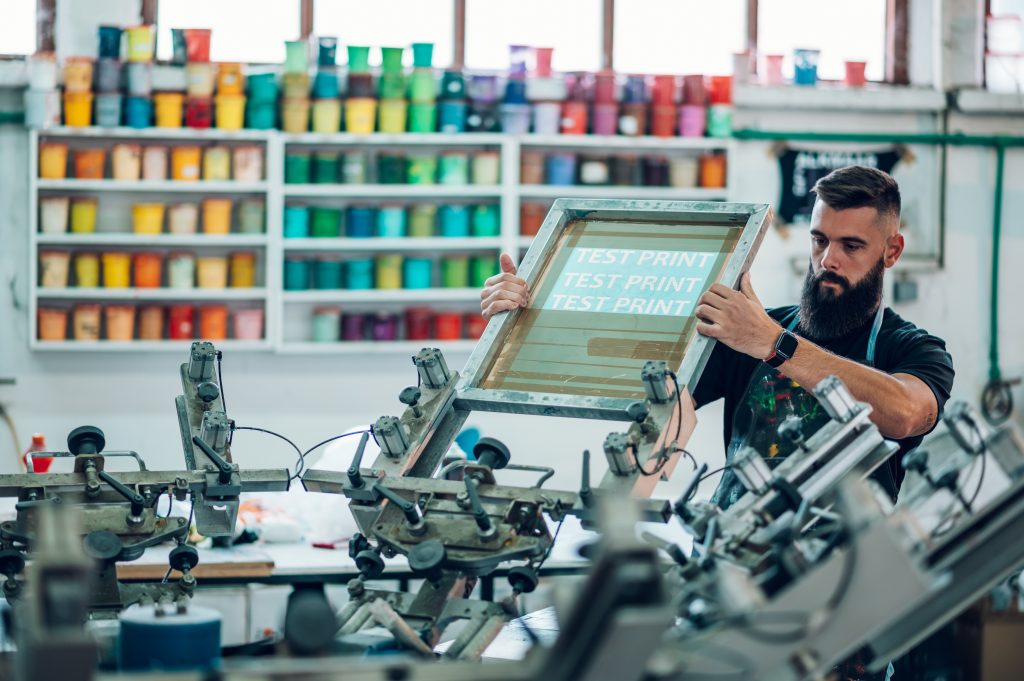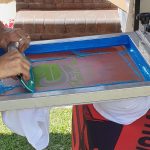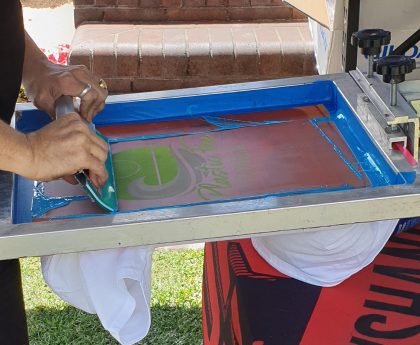Screen printing is a popular method for creating durable and vibrant designs on various surfaces, from t-shirts to posters. However, not all inks are created equal, and using the wrong ink can result in disappointing results. That’s why it’s crucial to choose the right ink for your projects, and I’m here to help you make that decision.
In this article, I’ll introduce you to the top 5 screen printing inks that have proven to deliver vibrant and long-lasting prints. Whether you’re a professional screen printer or a hobbyist, these inks will ensure that your designs stay bold and vibrant for years to come.
Types Of Screen Printing Inks
Screen printing is a popular printing technique with powerful printing capabilities for creating vibrant and long-lasting prints on a wide range of materials. The type of ink used in the screen printing process plays a crucial role in the outcome and durability of the prints. There are several types of screen printing inks available, each with its own unique characteristics and applications.
1. Water-Based Inks
Water-based inks are a popular choice for screen printing due to their softer feel, vibrant prints, and eco-friendly composition. These inks use water as the primary solvent, making them a more environmentally friendly alternative to traditional plastisol inks.
One of the main benefits of water-based inks is their soft-hand feel. When printed onto fabric, water-based inks penetrate the fibers, resulting in a print that is less noticeable to the touch. This is especially desirable for those seeking a more comfortable and natural feel.
Additionally, water-based inks offer vibrant and eye-catching prints. The ink colors appear more vibrant and translucent, allowing for a wider range of colors and a better color result overall. This makes them ideal for intricate or detailed designs that require precise color accuracy.
Furthermore, using water-based inks for screen printing is a greener choice as they have a lower environmental impact compared to traditional plastisol inks. Water is the primary solvent in these inks, reducing the need for harmful chemicals and decreasing air pollution.
However, it is important to note that water-based inks do have some drawbacks. They typically have longer drying and curing times compared to plastisol inks, requiring additional time and care during the printing process. Additionally, they may not be as suitable for printing on dark-colored garments as the ink colors can appear less vibrant and may require multiple layers for an opaque result.
2. Plastisol Ink
Plastisol ink is another popular type of ink used in screen printing, offering its own unique set of characteristics and advantages. One standout feature of plastisol ink is its exceptional opacity, making it the ideal choice for printing on dark garments or fabrics. The ink colors are highly saturated, resulting in vibrant and eye-catching prints that really pop.
Additionally, plastisol ink is known for its exceptional durability. Once cured, this ink creates a bond with the fabric, ensuring that the print withstands regular wear and tear without fading or cracking. This makes plastisol ink a great choice for garments that will be subjected to frequent washing or harsh conditions.
Another advantage of plastisol ink is its ability to accurately reproduce high-detail designs. The ink is thick and holds fine details exceptionally well, allowing for intricate images or text to be printed with clarity and precision. This makes plastisol ink the go-to option for printing logos or detailed graphics.
However, there are a few limitations to consider with plastisol ink. When used in large printed areas, the ink can feel heavier and more noticeable on the fabric compared to water-based inks. Additionally, plastisol ink requires heat curing to achieve proper adhesion and permanence, which adds an extra step to the printing process and may require specialized equipment.
3. Discharge Inks
Discharge inks are a type of water-based ink commonly used in screen printing to achieve vibrant colors on dark garments. Unlike traditional plastisol ink, discharge inks work by removing the existing color on the fabric and then replacing it with a new color. This unique process allows for bold and vibrant prints on dark fabrics.
Discharge inks are composed of a mixture of dyes or pigments, water, and a primary solvent. They also require the use of an activator, which is typically a separate chemical compound that initiates the color removal process. The activator works by breaking down the existing dye or pigment on the fabric, allowing for a clean canvas to apply the new color.
The application process for discharge inks involves several steps. First, the ink is mixed with the activator and applied to the screen mesh. Then, the screen is pressed onto the fabric, and the activator starts to remove the existing color. The fabric is then heat cured to fix the new color onto the garment permanently.
When using discharge inks, there are a few factors to consider. Firstly, high-quality emulsion is crucial to ensure proper ink transfer and color vibrancy. Additionally, the curing temperature must be carefully controlled to achieve optimal results. Discharge inks also have a limited pot life, meaning they should be used within a certain time frame to maintain their effectiveness.
4. Solvent-Based Inks
Solvent-based inks are a popular choice for screen printing due to their powerful printing capabilities and wide range of applications. These inks, as the name suggests, are composed of a primary solvent as the base, which provides excellent adhesion to a variety of materials, including synthetic fibers and fabric types that are typically challenging to print on.
Compared to water-based inks, solvent-based inks offer several advantages. Firstly, they produce vibrant and long-lasting prints that retain their color saturation even after multiple washes. This makes them ideal for printing on dark garments or fabrics with high dye absorption. Additionally, solvent-based inks have a smoother workability, allowing for detailed designs and precise color application.
Solvent-based inks offer versatility in terms of the range of materials they can be used on, including polyester, nylon, and other synthetic fabrics. They also adhere well to substrates like plastics and metals, making them suitable for printing on a wide variety of surfaces.
5. Silicone Ink
Silicone ink is a type of screen printing ink that offers unique characteristics and advantages, making it a top choice for vibrant and long-lasting prints. With its powerful printing capabilities, silicone ink delivers high-quality prints that boast vibrant colors and exceptional durability.
One of the notable advantages of silicone ink is its ability to adhere well to synthetic fabrics, making it perfect for printing on materials like polyester and nylon. This ink’s strong adhesion ensures that the prints remain vibrant and intact even after repeated washing and wear. In fact, silicone ink is renowned for its resistance to fading, ensuring that the prints maintain their original vibrancy over time.
Additionally, silicone ink offers flexibility and durability, making it suitable for a wide range of applications. It can easily accommodate detailed designs and intricate patterns, allowing for precise color application and outstanding print quality. Furthermore, its flexibility ensures that the prints retain their softness and do not crack or peel, even on stretchable fabrics.
For screen printers seeking vibrant and long-lasting prints on synthetic fabrics, silicone ink is an excellent choice. Its high-quality results, vibrant colors, durability, and resistance to fading make it a top contender in the world of screen printing inks.

Conclusion
In conclusion, choosing the right screen printing ink is crucial for achieving vibrant and long-lasting prints. The top 5 inks discussed in this article, including plastisol, water-based, discharge, silicone, and hybrid inks, each have their own unique advantages and applications. Whether you prioritize durability, eco-friendliness, or versatility, there is an ink option that will meet your specific needs.




